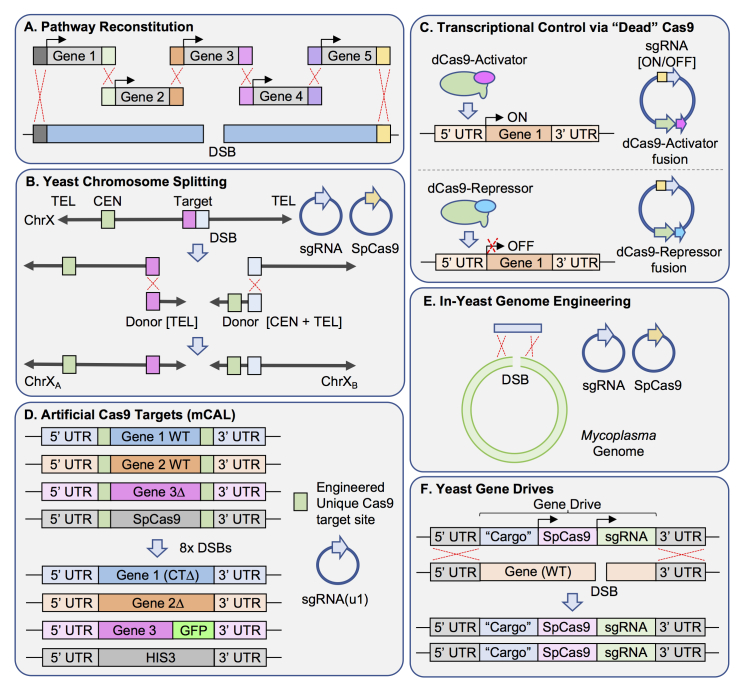Figure 1.
Diverse set of unique CRISPR/Cas9 methodologies employed in S. cerevisiae in recent years. (A) Traditional nuclease-based editing using Cas9 allows for the introduction of multiple non-native genes into the yeast genome in a single step. This study reconstituted the six genes (five illustrated) required for a pyruvate dehydrogenase complex (from E. faecalis) in vivo [43]. Each “Gene” represented contains both flanking UTR as well as unique 60-base pair segments (different colors used) to allow for homologous recombination. Following targeting of Cas9/sgRNA to the locus of interest, HR and subsequent integration of the entire six-gene cassette repairs the double-stranded break (DSB) and replaces the endogenous yeast gene. (B) Cas9 based method for chromosome splitting (CRISPR-PCS) [47]. A yeast chromosome (Arrow: telomere, Green box: centromere) is targeted for splitting into two or more smaller complete chromosomes by plasmid-expressed Cas9 and an sgRNA. Following introduction of the DSB, donor DNA is provided that will allow for repair of each fractured chromosome fragment. A homologous sequence (pink or blue) is included to link each unique donor DNA fragment to the appropriate chromosome segment. Left, the severed chromosome arm is lacking a telomere; the donor module includes a telomere seed sequence repeat. Right, the separated chromosome arm (now lacking a centromere) performs HR with the appropriate donor module to introduce both a capping telomere seed sequence and yeast centromere. This methodology allows for the generation of two (or more) functional chromosomes. (C) Transcriptional regulation of multiple yeast promoters using catalytic dead Cas9 (dCas9) fusions and an inducible sgRNA system [50]. The sgRNA cassette is under control of the TetO system (ON/OFF). Nuclease deficient Cas9 is fused to either a transcriptional activator (VPR; VP64-p65-RTA) or repressor (Mxi1). Expression of different sgRNAs recruits dCas9-A (activator) or dCas9-R (repressor) to the promoter element of interest (14 separate promoters tested with over 100 sgRNAs) to modulate transcription of the target gene(s). (D) Multiplexing using artificial Cas9 target sequences (mCAL) [28]. The introduction of non-native target sequences (20 bp target + 3 bp PAM) at multiple loci (illustrated as flanking three sample genes as well as an integrated copy of Cas9 at the HIS3 locus) allows for a single sgRNA construct (u1; unique sequence 1) to target this identical sequence at every position in the genome. Introduction of donor DNA with appropriate flanking sequence allows for HR-based integration of any version of each gene (full deletion, repair, domain deletions, point mutations, or tagged versions) as well as simultaneous excision of the Cas9-expressing cassette. (E) In-yeast genome engineering of a bacterial genome [59]. The combination of active Cas9, a targeting sgRNA (both on plasmids) as well as the entire Mycoplasma mycoides bacterial genome (1.2 Mb) was transformed into yeast. CRISPR-based DSB induction and subsequent HR-based repair (with a synthetic oligonucleotide) allowed for the deletion of a particular M. mycoides gene. (F) The study of gene drives using S. cerevisiae [67]. The Cas9-based “gene drive” consists of the following: (i) the Cas9 gene, (ii) the sgRNA-expressing cassette, and (iii) an optional “cargo” for a new or modified gene. In yeast, the sgRNA can be expressed from a plasmid or be integrated as the site of the drive. The entire drive is integrated into the genome and replaces (full or partial deletion) an endogenous gene. Activation of the gene drive system causes targeting of Cas9 to the homologous WT gene copy on the opposite chromosome (in a diploid yeast cell). Creation of the DSB induces HR-based repair using the entire flanking chromosomal sequence as donor DNA. Therefore, the entirety of the gene drive is copied and replaces the endogenous WT gene target. Illustrations are adapted from various sources.

